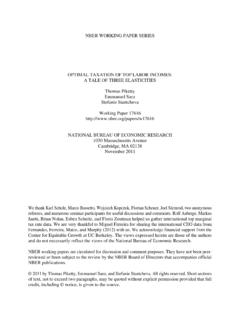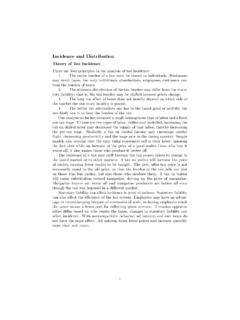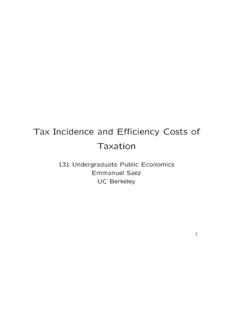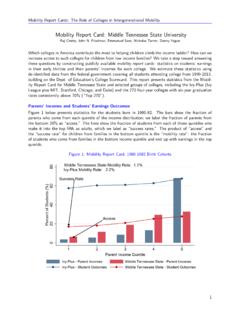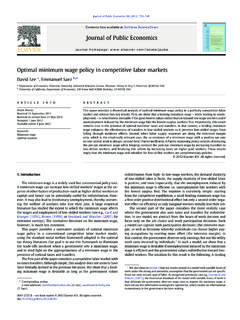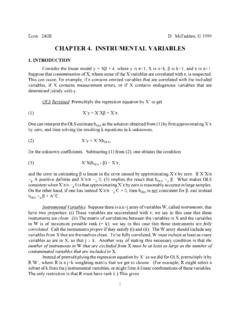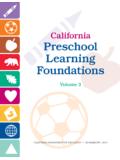Transcription of The Effect of Education on Crime: Evidence from Prison ...
1 The Effect of Education on crime : Evidence from Prison Inmates, Arrests, and Self-Reports By LANCE LOCHNER AND ENRICO MORETTI*. We estimate the Effect of Education on participation in criminal activity using changes in state compulsory schooling laws over time to account for the endoge- neity of schooling decisions. Using Census and FBI data, we find that schooling significantly reduces the probability of incarceration and arrest. NLSY data indicate that our results are caused by changes in criminal behavior and not differences in the probability of arrest or incarceration conditional on crime . We estimate that the social savings from crime reduction associated with high school graduation (for men) is about 14 26 percent of the private return. (JEL I2, K42). Is it possible to reduce crime rates by raising returns received by individuals. In particular, a the Education of potential criminals? If so, number of studies attempt to determine whether would it be cost effective with respect to other the schooling of one worker raises the produc- crime prevention measures?
2 Despite the enor- tivity and earnings of other workers around him. mous policy implications, little is known about [For example, see James Heckman and Peter the relationship between schooling and criminal Klenow (1999), Daron Acemoglu and Joshua behavior. Angrist (2000), and Moretti (2004a, b).] Yet, The motivation for these questions is not little research has been undertaken to evaluate limited to the obvious policy implications for the importance of other types of external bene- crime prevention. Estimating the Effect of edu- fits of Education , such as its potential effects on cation on criminal activity may shed some light on the magnitude of the social return to educa - crime is a negative externality with enor- tion. Economists interested in the benefits of mous social costs. If Education reduces crime , schooling have traditionally focused on the pri- then schooling will have social benefits that are vate return to Education . However, researchers not taken into account by individuals.
3 In this have recently started to investigate whether case, the social return to Education may exceed schooling generates benefits beyond the private the private return. Given the large social costs of crime , even small reductions in crime asso- ciated with Education may be economically * Lochner: Department of Economics, University of Western Ontario, 1151 Richmond Street, London, Ontario, important. N6A 5C2, Canada (e-mail: Moretti: De- There are a number of reasons to believe that partment of Economics, UCLA, 405 Hilgard Avenue, Los Education will affect subsequent crime . First, Angeles, CA 90095 (e-mail: We schooling increases the returns to legitimate are grateful to Daron Acemoglu and Josh Angrist for their work, raising the opportunity costs of illicit data on compulsory attendance laws and useful suggestions. We thank Mark Bils, Elizabeth Caucutt, Janet Currie, Gor- Additionally, punishment for crime don Dahl, Stan Engerman, Jeff Grogger, Jinyong Hahn, Guido Imbens, Shakeeb Khan, David Levine, Jens Lud- 1.))
4 Wig, Darren Lubotsky, Marco Manacorda, Marcelo Ann D. Witte (1997) and Lochner (2003) are notable Moreira, David Mustard, Peter Rupert, Steve Rivkin, Todd exceptions. 2. Stinebrickner, Edward Vytlacil, Tiemen Woutersen, two W. K. Viscusi (1986), Richard Freeman (1996), Jeffrey referees, and seminar participants at Columbia University, Grogger (1998), Stephen Machin and Costas Meghir Chicago GSB, NBER Summer Institute, Econometric Soci- (2000), and Eric D. Gould et al. (2002) empirically establish ety, University of Rochester, UCLA, University of British a negative correlation between earnings levels (or wage Columbia, Hoover Institution, and Stanford University for rates) and criminal activity. The relationship between crime their helpful comments. All the data used in the paper are and unemployment has been more tenuous (see Freeman, available at 1983, 1995, or Theodore Chiricos, 1987, for excellent sur- 155. 156 THE AMERICAN ECONOMIC REVIEW MARCH 2004. typically entails incarceration.)
5 By raising wage sult, we might expect a negative correlation rates, schooling makes this lost time more between crime and Education even if there is no costly. Second, Education may directly affect causal Effect of Education on crime . State poli- the financial or psychic rewards from crime cies may induce bias with the opposite sign if itself. Finally, schooling may alter preferences increases in state spending for crime prevention in indirect ways, which may affect decisions to and Prison construction trade off with spending engage in crime . For example, Education may for public Education , a positive spurious corre- increase one's patience or risk aversion. On net, lation between Education and crime is also we expect that most of these channels will lead possible. to a negative relationship between Education To address endogeneity problems, we use and typical violent and property crimes. changes in state compulsory attendance laws Despite the many reasons to expect a causal over time to instrument for schooling.
6 Changes link between Education and crime , empirical in these laws have a significant Effect on edu- research is not The key difficulty in cational achievement, and we find little evi- estimating the Effect of Education on criminal dence that changes in these laws simply reflect activity is that unobserved characteristics af- preexisting trends toward higher schooling lev- fecting schooling decisions are likely to be cor- els. In the years preceding increases in compul- related with unobservables influencing the sory schooling laws, there is no obvious trend in decision to engage in crime . For example, indi- schooling achievement. Increases in Education viduals with high criminal returns or discount associated with increased compulsory schooling rates are likely to spend much of their time take place after changes in the law. Further- engaged in crime rather than work regardless of more, increases in the number of years of com- their educational background. To the extent that pulsory attendance raise high school graduation schooling does not raise criminal returns, there rates but have no Effect on college graduation is little reward to finishing high school or at- rates.
7 These two facts indicate that the increases tending college for these individuals. As a re- in compulsory schooling raise Education , not vice versa. We also examine whether increases in compulsory schooling ages are associated veys); however, a number of recent studies that better ad- with increases in state resources devoted to dress problems with endogeneity and unobserved correlates fighting crime . They are not. (including Steven Raphael and Rudolf Winter-Ebmer, 2001, We use individual-level data on incarceration and Gould et al., 2002) find a sizeable positive Effect of unemployment on crime . from the Census and cohort-level data on arrests 3. Witte (1997) concludes that .. neither years of school- by state from the FBI Uniform crime Reports ing completed nor receipt of a high school degree has a (UCR) to analyze the effects of schooling on significant Effect on an individual's level of criminal activ- crime . We then turn to self-report data on crim- ity. But, this conclusion is based on only a few available studies, including Helen Tauchen et al.
8 (1994) and Witte inal activity from the National Longitudinal and Tauchen (1994), which find no significant link between Survey of Youth (NLSY) to verify that the Education and crime after controlling for a number of indi- estimated impacts measure changes in crime vidual characteristics. While Grogger (1998) estimates a and not educational differences in the probabil- significant negative relationship between wage rates and ity of arrest or incarceration conditional on crime , he finds no relationship between Education and crime after controlling for wages. (Of course, increased wages are crime . We employ a number of empirical strat- an important consequence of schooling.) More recently, egies to account for unobservable individual Lochner (2003) estimates a significant and important link characteristics and state policies that may intro- between high school graduation and crime using data from duce spurious correlation. the National Longitudinal Survey of Youth (NLSY).
9 Other research relevant to the link between Education and crime We start by analyzing the Effect of Education has examined the correlation between crime and time spent on incarceration. The group quarters type of in school (Michael Gottfredson, 1985; David Farrington et residence in the Census indicates whether an al., 1986; and Witte and Tauchen, 1994). These studies find individual is incarcerated at the Census date. that time spent in school significantly reduces criminal For both blacks and whites, ordinary least- activity more so than time spent at work suggesting a contemporaneous link between school attendance and squares (OLS) estimates uncover significant re- crime . Previous empirical studies have not controlled for the ductions in the probability of incarceration endogeneity of schooling. associated with more schooling. Instrumental VOL. 94 NO. 1 LOCHNER AND MORETTI: THE Effect OF Education ON crime 157. variable estimates reveal a significant relation- obtained using Census data for both blacks and ship between Education and incarceration, and whites.
10 They suggest that the impacts are greater for Given the general consistency in findings blacks than for whites. One extra year of across data sets, measures of criminal activity, schooling results in a re- and identification strategies, we cannot reject duction in the probability of incarceration for that a relationship between Education and crime whites, and a reduction exists. Using our estimates, we calculate the for blacks. To help in interpreting the size of social savings from crime reduction associated these impacts, we calculate how much of the with high school completion. Our estimates black-white gap in incarceration rates in 1980 is suggest that a 1-percent increase in male high due to differences in educational attainment. Dif- school graduation rates would save as much as ferences in average Education between blacks and $ billion, or about $2,100 per additional male whites can explain as much as 23 percent of the high school graduate. These social savings rep- black-white gap in incarceration rates.

